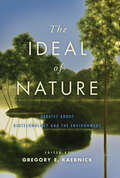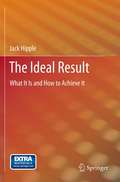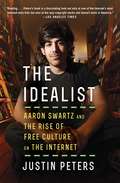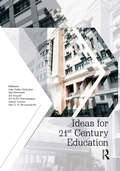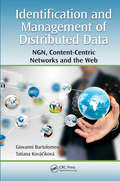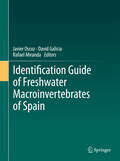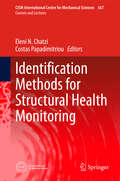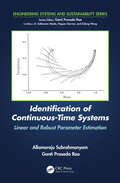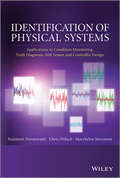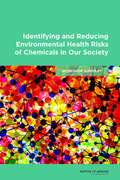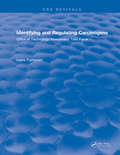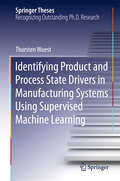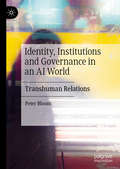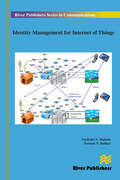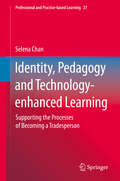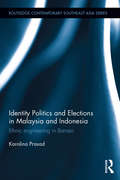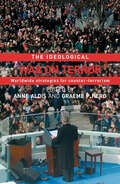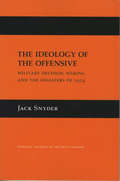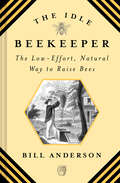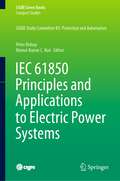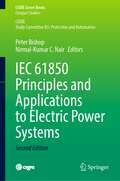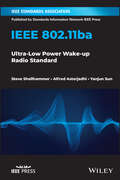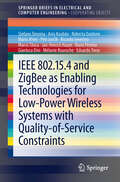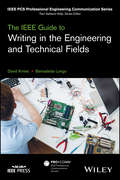- Table View
- List View
The Ideal of Nature: Debates about Biotechnology and the Environment
by Gregory E. KaebnickIn this provocative anthology, scholars consider the meaning and merits of “nature” in debates about biotechnology and the environment.Drawing on philosophy, religion, and political science, this book asks what the term “nature” means, how it should be considered, and if it is—even in part—a social construct. The contributors question if the quality of being “natural” is intrinsically valuable. They also discuss whether appeals to nature can and should affect public policy and, if so, whether they are moral trump cards or should instead be weighed against other concerns.Though consensus on these questions remains elusive, this should not be an obstacle to moving the debate forward. By bringing together disparate approaches to addressing these concepts, The Ideal of Nature suggests the possibility of intermediate positions that move beyond the usual full-throated defense and blanket dismissal found in much of the debate. Scholars of bioethics, environmental philosophy, religious studies, sociology, public policy, and political theory will find much merit in this book’s lively discussion.
The Ideal Result
by Jack HippleThe Ideal Final Result introduces the TRIZ Inventive Problem Solving Process in a way that allows readers to make immediate use of its most basic concepts. The Ideal Final Result reviews the basics of this left brained, but at the same time, very creative process for problem solving that uses a basic algorithm developed through the study of millions of patents. As opposed to psychologically based tools relying on the generation of hundreds of ideas to be sorted through to find the few of value, TRIZ rigorously defines the problem and assists the problem owner in identifying the existing inventive principles that are already known to solve that class of problems. This book reviews the most basic of the TRIZ algorithm tools and provides templates for readers to use in analyzing their difficult problems and provides a mental framework for their solution. It also describes TRIZ techniques for basic strategic planning in a business sense.
The Idealist
by Justin PetersA smart, lively history of the Internet free culture movement and its larger effects on society--and the life and shocking suicide of Aaron Swartz, a founding developer of Reddit and Creative Commons--from Slate correspondent Justin Peters.Aaron Swartz was a zealous young advocate for the free exchange of information and creative content online. He committed suicide in 2013 after being indicted by the government for illegally downloading millions of academic articles from a nonprofit online database. From the age of fifteen, when Swartz, a computer prodigy, worked with Lawrence Lessig to launch Creative Commons, to his years as a fighter for copyright reform and open information, to his work leading the protests against the Stop Online Piracy Act (SOPA), to his posthumous status as a cultural icon, Swartz's life was inextricably connected to the free culture movement. Now Justin Peters examines Swartz's life in the context of 200 years of struggle over the control of information. In vivid, accessible prose, The Idealist situates Swartz in the context of other "data moralists" past and present, from lexicographer Noah Webster to ebook pioneer Michael Hart to NSA whistleblower Edward Snowden. In the process, the book explores the history of copyright statutes and the public domain; examines archivists' ongoing quest to build the "library of the future"; and charts the rise of open access, copyleft, and other ideologies that have come to challenge protectionist IP policies. Peters also breaks down the government's case against Swartz and explains how we reached the point where federally funded academic research came to be considered private property, and downloading that material in bulk came to be considered a federal crime. The Idealist is an important investigation of the fate of the digital commons in an increasingly corporatized Internet, and an essential look at the impact of the free culture movement on our daily lives and on generations to come.
The Idealist: Aaron Swartz and the Rise of Free Culture on the Internet
by Justin PetersThis smart, “riveting” (Los Angeles Times) history of the Internet free culture movement and its larger effects on society—and the life and shocking suicide of Aaron Swartz, a founding developer of Reddit and Creative Commons—written by Slate correspondent Justin Peters “captures Swartz flawlessly” (The New York Times Book Review).Aaron Swartz was a zealous young advocate for the free exchange of information and creative content online. He committed suicide in 2013 after being indicted by the government for illegally downloading millions of academic articles from a nonprofit online database. From the age of fifteen, when Swartz, a computer prodigy, worked with Lawrence Lessig to launch Creative Commons, to his years as a fighter for copyright reform and open information, to his work leading the protests against the Stop Online Piracy Act (SOPA), to his posthumous status as a cultural icon, Swartz’s life was inextricably connected to the free culture movement. Now Justin Peters examines Swartz’s life in the context of 200 years of struggle over the control of information. In vivid, accessible prose, The Idealist situates Swartz in the context of other “data moralists” past and present, from lexicographer Noah Webster to ebook pioneer Michael Hart to NSA whistleblower Edward Snowden. In the process, the book explores the history of copyright statutes and the public domain; examines archivists’ ongoing quest to build the “library of the future”; and charts the rise of open access, the copyleft movement, and other ideologies that have come to challenge protectionist intellectual property policies. Peters also breaks down the government’s case against Swartz and explains how we reached the point where federally funded academic research came to be considered private property, and downloading that material in bulk came to be considered a federal crime. The Idealist is “an excellent survey of the intellectual property battlefield, and a sobering memorial to its most tragic victim” (The Boston Globe) and an essential look at the impact of the free culture movement on our daily lives and on generations to come.
Ideas for 21st Century Education: Proceedings of the Asian Education Symposium (AES 2016), November 22-23, 2016, Bandung, Indonesia
by Ade Gafar Abdullah Ida Hamidah Siti Aisyah Ari Arifin Danuwijaya Galuh Yuliani Heli S.H. MunawarohIdeas for 21st Century Education contains the papers presented at the Asian Education Symposium (AES 2016), held on November 22—23, 2016, in Bandung, Indonesia. The book covers 11 topics: <P><P>1. Art Education (AED)2. Adult Education (ADE)3. Business Education (BED)4. Course Management (CMT)5. Curriculum, Research and Development (CRD)6. Educational Foundations (EDF)7. Learning / Teaching Methodologies and Assessment (TMA)8. Global Issues in Education and Research (GER)9. Pedagogy (PDG)10. Ubiquitous Learning (UBL)11. Other Areas of Education (OAE)
Identification and Management of Distributed Data: NGN, Content-Centric Networks and the Web
by Giovanni Bartolomeo Tatiana KovacikovaAlthough several books and academic courses discuss data management and networking, few of them focus on the convergence of networking and software technologies for identifying, addressing, and managing distributed data. Focusing on this convergence, Identification and Management of Distributed Data: NGN, Content-Centric Networks and the Web collat
Identification Guide of Freshwater Macroinvertebrates of Spain
by David Galicia Javier Oscoz Rafael MirandaAs a result of the European Commission's concern for the status of continental waters, and as a clear reflection of the notion of water as heritage to be conserved, in the year 2000 the Water Framework Directive (2000/60/CE) was enacted, its goal being to establish a framework to protect water and the different aquatic ecosystems by requiring the Member States to achieve a good ecological status in all their waters by 2015. Like all ecosystems, freshwater ecosystems undergo physical, chemical and energy-related changes, both of natural and anthropogenic origin. These disturbances affect the organisms living in them and those who utilize their resources. Therefore, evaluating these changes has become a very important task in order to better understand aquatic systems. The study and analysis of the ecological status of these ecosystems in relation to their conservation status and water quality is thus a fundamental tool for a more efficient and rational management of their resources, that is, a management that does not threaten the ecosystem. The present guide for the identification of Spanish freshwater macroinvertebrates aims to facilitate the job of those who go to great lengths to identify them in order to then determine biotic indices. It is not the aim of this book to serve as a zoological treaty, nor does it claim to add new information on the biology or the ecology of the taxa covered. This book is, simply, a working tool explicitly designed to facilitate the identification of the Spanish macroinvertebrates and the subsequent computing of biotic indices.
Identification Methods for Structural Health Monitoring
by Eleni N. Chatzi Costas PapadimitriouThe papers in this volume provide an introduction to well known and established system identification methods for structural health monitoring and to more advanced, state-of-the-art tools, able to tackle the challenges associated with actual implementation. Starting with an overview on fundamental methods, introductory concepts are provided on the general framework of time and frequency domain, parametric and non-parametric methods, input-output or output only techniques. Cutting edge tools are introduced including, nonlinear system identification methods; Bayesian tools; and advanced modal identification techniques (such as the Kalman and particle filters, the fast Bayesian FFT method). Advanced computational tools for uncertainty quantification are discussed to provide a link between monitoring and structural integrity assessment. In addition, full scale applications and field deployments that illustrate the workings and effectiveness of the introduced monitoring schemes are demonstrated.
Identification of Continuous-Time Systems: Linear and Robust Parameter Estimation (Engineering Systems and Sustainability)
by Allamaraju Subrahmanyam Ganti Prasada RaoModels of dynamical systems are required for various purposes in the field of systems and control. The models are handled either in discrete time (DT) or in continuous time (CT). Physical systems give rise to models only in CT because they are based on physical laws which are invariably in CT. In system identification, indirect methods provide DT models which are then converted into CT. Methods of directly identifying CT models are preferred to the indirect methods for various reasons. The direct methods involve a primary stage of signal processing, followed by a secondary stage of parameter estimation. In the primary stage, the measured signals are processed by a general linear dynamic operation—computational or realized through prefilters, to preserve the system parameters in their native CT form—and the literature is rich on this aspect. In this book: Identification of Continuous-Time Systems-Linear and Robust Parameter Estimation, Allamaraju Subrahmanyam and Ganti Prasada Rao consider CT system models that are linear in their unknown parameters and propose robust methods of estimation. This book complements the existing literature on the identification of CT systems by enhancing the secondary stage through linear and robust estimation. In this book, the authors provide an overview of CT system identification, consider Markov-parameter models and time-moment models as simple linear-in-parameters models for CT system identification, bring them into mainstream model parameterization via basis functions, present a methodology to robustify the recursive least squares algorithm for parameter estimation of linear regression models, suggest a simple off-line error quantification scheme to show that it is possible to quantify error even in the absence of informative priors, and indicate some directions for further research. This modest volume is intended to be a useful addition to the literature on identifying CT systems.
Identification of Physical Systems
by Maryhelen Stevenson Rajamani Doraiswami Chris DiduchIdentification of a physical system deals with the problem of identifying its mathematical model using the measured input and output data. As the physical system is generally complex, nonlinear, and its input-output data is corrupted noise, there are fundamental theoretical and practical issues that need to be considered. Identification of Physical Systems addresses this need, presenting a systematic, unified approach to the problem of physical system identification and its practical applications. Starting with a least-squares method, the authors develop various schemes to address the issues of accuracy, variation in the operating regimes, closed loop, and interconnected subsystems. Also presented is a non-parametric signal or data-based scheme to identify a means to provide a quick macroscopic picture of the system to complement the precise microscopic picture given by the parametric model-based scheme. Finally, a sequential integration of totally different schemes, such as non-parametric, Kalman filter, and parametric model, is developed to meet the speed and accuracy requirement of mission-critical systems. Key features: Provides a clear understanding of theoretical and practical issues in identification and its applications, enabling the reader to grasp a clear understanding of the theory and apply it to practical problems Offers a self-contained guide by including the background necessary to understand this interdisciplinary subject Includes case studies for the application of identification on physical laboratory scale systems, as well as number of illustrative examples throughout the book Identification of Physical Systems is a comprehensive reference for researchers and practitioners working in this field and is also a useful source of information for graduate students in electrical, computer, biomedical, chemical, and mechanical engineering.
Identifying and Reducing Environmental Health Risks of Chemicals in Our Society: Workshop Summary
by Robert PoolOn November 7-8, 2013, the Institute of Medicine's Roundtable on Environmental Health Sciences, Research, and Medicine held a workshop to discuss approaches related to identifying and reducing potential environmental public health risks to new and existing industrial chemicals present in society. Industrial chemicals include chemicals used in industrial processes or commercial products, not including those found in food, pesticides, or pharmaceuticals. Identifying and Reducing Environmental Health Risks of Chemicals in Our Society is a summary and synthesis of the presentations and discussions that took place during the two days of the workshop. The workshop examined successes and areas for improvement within current regulatory programs for assessing industrial chemical safety, frameworks for chemical prioritization to inform targeted testing and risk management strategies, concepts of sustainability and green chemistry that support the design and use of safer alternatives, and efforts to reduce the risk of chemicals in our society.
Identifying and Regulating Carcinogens
by Lewis PublishersThis excellent resource describes the various Federal agency programs, guidelines, laws, and requirements regarding potential exposure to carcinogens in the environment-ambient air, water, and soil-workplace environment-food and drugs and other consumer products. It covers 16 different programs, activities, and Federal agencies. The reader is provided insight into the background and rationale behind current Federal Policy and regulations relating to public health and potential carcinogenic hazards. Necessary differentiation among Hazard Identification, risk characterization, risk assessment, and risk management are clearly described. This guide should prove valuable to scientists, engineers, and managers-companies, governments, universities, and consultants.
Identifying Product and Process State Drivers in Manufacturing Systems Using Supervised Machine Learning
by Thorsten WuestThe book reports on a novel approach for holistically identifying the relevant state drivers of complex, multi-stage manufacturing systems. This approach is able to utilize complex, diverse and high-dimensional data sets, which often occur in manufacturing applications, and to integrate the important process intra- and interrelations. The approach has been evaluated using three scenarios from different manufacturing domains (aviation, chemical and semiconductor). The results, which are reported in detail in this book, confirmed that it is possible to incorporate implicit process intra- and interrelations on both a process and programme level by applying SVM-based feature ranking. In practice, this method can be used to identify the most important process parameters and state characteristics, the so-called state drivers, of a manufacturing system. Given the increasing availability of data and information, this selection support can be directly utilized in, e. g. , quality monitoring and advanced process control. Importantly, the method is neither limited to specific products, manufacturing processes or systems, nor by specific quality concepts.
Identity, Institutions and Governance in an AI World: Transhuman Relations
by Peter BloomThe 21st century is on the verge of a possible total economic and political revolution. Technological advances in robotics, computing and digital communications have the potential to completely transform how people live and work. Even more radically, humans will soon be interacting with artificial intelligence (A.I.) as a normal and essential part of their daily existence. What is needed now more than ever is to rethink social relations to meet the challenges of this soon-to-arrive "smart" world. This book proposes an original theory of trans-human relations for this coming future. Drawing on insights from organisational studies, critical theory, psychology and futurism - it will chart for readers the coming changes to identity, institutions and governance in a world populated by intelligent human and non-human actors alike. It will be characterised by a fresh emphasis on infusing programming with values of social justice, protecting the rights and views of all forms of "consciousness" and creating the structures and practices necessary for encouraging a culture of "mutual intelligent design". To do so means moving beyond our anthropocentric worldview of today and expanding our assumptions about the state of tomorrow's politics, institutions, laws and even everyday existence. Critically such a profound shift demands transcending humanist paradigms of a world created for and by humans and instead opening ourselves to a new reality where non-human intelligence and cyborgs are increasingly central.
Identity Management for Internet of Things (River Publishers Series In Communications Ser.)
by Parikshit N. Mahalle Poonam N. RailkarThe Internet of Things is a wide-reaching network of devices, and these devices can intercommunicate and collaborate with each other to produce variety of services at any time, any place, and in any way. Maintaining access control, authentication and managing the identity of devices while they interact with other devices, services and people is an important challenge for identity management. The identity management presents significant challenges in the current Internet communication. These challenges are exacerbated in the internet of things by the unbound number of devices and expected limitations in constrained resources. Current identity management solutions are mainly concerned with identities that are used by end users, and services to identify themselves in the networked world. However, these identity management solutions are designed by considering that significant resources are available and applicability of these identity management solutions to the resource constrained internet of things needs a thorough analysis. Technical topics discussed in the book include:• Internet of Things;• Identity Management;• Identity models in Internet of Things;• Identity management and trust in the Internet of Things context;• Authentication and access control;Identitymanagement for Internet of Things contributes to the area of identity management for ubiquitous devices in the Internet of Things. It initially presents the motivational factors together with the identity management problems in the context of Internet of Things and proposes an identity management framework. Following this, it refers to the major challenges for Identitymanagement and presents different identity management models. This book also presents relationship between identity and trust, different approaches for trust management, authentication and access control.
Identity, Pedagogy and Technology-enhanced Learning: Supporting the Processes of Becoming a Tradesperson (Professional and Practice-based Learning #27)
by Selena ChanThis book gathers work from over a decade of study, and seeks to better understand and support how learners become tradespeople. The research programme applies recent concepts from neuroscience, educational psychology and technology-enhanced learning to explain and help overcome the challenges of learning in trades-learning contexts. Due to the complex and multifarious nature of the work characterising trade occupations, learning how to become a tradesperson requires a significant commitment in terms of time, along with physical and cognitive effort. All modalities (visual, aural, haptic etc.) and literacies (text, numerical, spatial etc.) are required when undertaking trade work. Manual dexterity and strength, coupled with the technical and tacit knowledge required for complex problem solving, not to mention suitable dispositional approaches, must all be learnt and focused on becoming a tradesperson.However, there is a substantial gap in the literature on 'how people learn a trade' and 'how to teach a trade'. In this book, contemporary teaching and learning approaches and strategies, as derived through practice-based participatory research, are used to highlight and discuss pragmatic solutions to facilitate the learning and teaching of trade skills, knowledge and dispositions. The approaches and strategies discussed include the implementation of technology-enhanced learning; project-based inquiry/problem-based learning; and recommendations to ensure learners are prepared for the future of work.
Identity Politics and Elections in Malaysia and Indonesia: Ethnic Engineering in Borneo (Routledge Contemporary Southeast Asia Series)
by Karolina PrasadIn recent social research, ethnicity has mostly been used as an explanatory variable. It was only after it was agreed that ethnicity, in itself, is subject to change, were the questions of how and why it changes, possible to answer. This multiplicity of ethnic identities requires that we think of each society as one with multiple ethnic dimensions, of which any can become activated in the process of political competition - and sometimes several of them within a short period of time. Focusing on Malaysia and Indonesia, this book traces the variations of ethnic identity by looking at electoral strategies in two sub-national units. It shows that ethnic identities are subject to change - induced by calculated moves by political entrepreneurs who use identities as tools to maximize their chances of winning elections or expanding support base - and highlights how political institutions play an enormous role in shaping the modes and dynamics of these ethno-political manipulations. The book suggests that in societies where ethnic identities are activated in politics, instead of analysing politics with ethnic distribution as an independent variable, ethnic distribution can be taken as the dependent variable, with political institutions being the explanatory one. It examines the problems of voters’ behaviour, and parties’ and candidates’ strategy in a polity that is, to a significant extent, driven by ethnic relations. Pushing the boundaries of qualitative research on Southeast Asian politics by placing formal institutions at the centre of its analysis, this book will be of interest to students and scholars of Southeast Asian Politics, Race and Ethnic Studies, and International Relations.
The Ideological War on Terror: Worldwide Strategies For Counter-Terrorism (Political Violence)
by Graeme P. Herd Anne AldisThis edited book addresses the appropriateness of US and other counter-terrorist (CT) strategies in Europe and Eurasia, the Middle East, the Asia Pacific region and in Latin America, with a view to improving their effectiveness. The book has three main objectives: to re-examine terrorists' strategic goals and sources of legitimacy and the nature of their ideological support to analyze current US and regional CT strategies and assess their success in de-legitimizing terrorists and undermining their support to provide a strategic synthesis and policy recommendations in light of the research findings. This book will be of interest to students of political violence and terrorism, security studies and international relations in general.
The Ideology of the Offensive
by Jack SnyderJack Snyders analysis of the attitudes of military planners in the years prior to the Great War offers new insight into the tragic miscalculations of that era and into their possible parallels in present-day war planning. By 1914, the European military powers had adopted offensive military strategies even though there was considerable evidence to support the notion that much greater advantage lay with defensive strategies. The author argues that organizational biases inherent in military strategists attitudes make war more likely by encouraging offensive postures even when the motive is self-defense. Drawing on new historical evidence of the specific circumstances surrounding French, German, and Russian strategic policy, Snyder demonstrates that it is not only rational analysis that determines strategic doctrine, but also the attitudes of military planners. Snyder argues that the use of rational calculation often falls victim to the pursuit of organizational interests such as autonomy, prestige, growth, and wealth. Furthermore, efforts to justify the preferred policy bring biases into strategists decisions biases reflecting the influences of parochial interests and preconceptions, and those resulting from attempts to simplify unduly their analytical tasks. The frightening lesson here is that doctrines can be destabilizing even when weapons are not, because doctrine may be more responsive to the organizational needs of the military than to the implications of the prevailing weapons technology. By examining the historical failure of offensive doctrine, Jack Snyder makes a valuable contribution to the literature on the causes of war.
The Idle Beekeeper: The Low-Effort, Natural Way to Raise Bees
by Bill AndersonFrom building a hive to harvesting honey, a top urban beekeeper shares how to care for bees the simple, mindful way. Global bee populations have been rapidly declining for years, and it’s not just our honey supply that’s at stake: the contribution of bees to the pollination of crops is essential to human survival. But even in industrial apiaries, bees are in distress, hiving in synthetic and hostile environments. Enter idle beekeeping: the grassroots, low-intervention system that seeks to emulate the behavior and habitat of bees in the wild—and it only requires two active days of beekeeping per year, one in the spring and another in the fall. In The Idle Beekeeper, Bill Anderson calls upon his years of applied curiosity as an urban beekeeper to celebrate these underappreciated insects and show how simple and rewarding beekeeping can be. In this entertaining, philosophical, and practical guide, Anderson shares why and how to build a hive system that is both cutting-edge and radically old. Maximum idleness is achieved through step-by-step directions to help the beekeeper gently harvest honey with minimum effort, make mead and beeswax candles, and closely observe and understand these fascinating and productive social creatures. For anyone interested in keeping bees, The Idle Beekeeper is the definitive guide to getting started, even in a city, and without effort.
IEC 61850 Principles and Applications to Electric Power Systems (CIGRE Green Books)
by Peter Bishop Nirmal-Kumar C. NairThis book offers a compact guide to IEC61850 systems, including wide-area implementation, as it has been applied to real substations worldwide. It utilises technical brochures and papers based on existing practice of IEC61850 systems that give stakeholders from different disciplines an understanding of systems in use, their features, how they are applied and approach for implementation. The book offers a holistic practical view considering all relevant interfaces and possibilities. It includes the different applications, practical implementation considerations and choices made for IEC61850 PACS (Protection Automation & Control System) designs. Power system engineers, planners, technicians and researchers will find the book useful for exploring, developing and delivering these systems.
IEC 61850 Principles and Applications to Electric Power Systems (CIGRE Green Books)
by Peter Bishop Nirmal-Kumar C. NairThis book offers a compact guide to IEC61850 systems, including wide-area implementation, as it has been applied to real substations worldwide. It utilises technical brochures and papers based on existing practice of IEC61850 systems that give stakeholders from different disciplines an understanding of systems in use, their features, how they are applied, and approach for implementation. The book offers a holistic practical view considering all relevant interfaces and possibilities. It includes the different applications, practical implementation considerations and choices made for IEC61850 PACS (Protection Automation & Control System) designs. Power system engineers, planners, technicians and researchers will find the book useful for exploring, developing and delivering these systems.This second edition of the book includes publication quality corrections. The technical content remains unaltered.
IEEE 802.11ba: Ultra-Low Power Wake-up Radio Standard
by Steve Shellhammer Alfred Asterjadhi Yanjun SunIEEE 802.11ba Discover the latest developments in IEEE 802.11ba and Wake-up Radios In IEEE 802.11ba: Ultra-Low Power Wake-up Radio Standard, expert engineers Drs. Steve Shellhammer, Alfred Asterjadhi, and Yanjun Sun deliver a detailed discussion of the IEEE 802.11ba standard. The book begins by explaining the concept of a wake-up radio (WUR) and how it fits into the overall 802.11 standard, as well as how a WUR saves power and extends battery life. The authors go on to describe the medium access control (MAC) layer in detail and then talk about the various protocols used to negotiate WUR operation, its uses for different functionalities (like wake up of the main radio, discovery, synchronization, and security). The book offers a detailed description of the physical (PHY) layer packet construction and the rationale for the design, as well as the various design aspects of the medium access control layer. It also includes: A thorough introduction to the motivations driving the development of the WUR in 802.11 Practical overviews of IEEE 802.11, including the basic concepts of 802.11 (the PHY and MAC) and background material on current low power modes Comprehensive discussions of the physical layer and PHY layer performance, including the generic receiver, the PPDU, Transmit Diversity, and the FDMA mode In-depth examinations of the medium access layer and its frame designs Perfect for professional wireless engineers, IEEE 802.11ba: Ultra-Low Power Wake-up Radio Standard will also earn a place in the libraries of academics and students researching and studying in fields involving wireless communications.
IEEE 802.15.4 and ZigBee as Enabling Technologies for Low-Power Wireless Systems with Quality-of-Service Constraints
by Petr Jurčík Ricardo Severino Stefano Tennina Roberta Daidone Gianluca Dini Nuno Pereira Marco Tiloca Mélanie Bouroche Anis Koubâa Jan-Hinrich Hauer Mário Alves Eduardo TovarThis book outlines the most important characteristics of IEEE 802.15.4 and ZigBee and how they can be used to engineer Wireless Sensor Network (WSN) systems and applications, with a particular focus on Quality-of-Service (QoS) aspects. It starts by providing a snapshot of the most relevant features of these two protocols, identifying some gaps in the standard specifications. Then it describes several state-of-the-art open-source implementations, models and tools that have been designed by the authors and have been widely used by the international community. The book also outlines the fundamental performance limits of IEEE 802.15.4/ZigBee networks, based on well-sustained analytical, simulation and experimental models, including how to dimension such networks to optimize delay/energy trade-offs.
The IEEE Guide to Writing in the Engineering and Technical Fields
by David Kmiec Bernadette LongoHelps both engineers and students improve their writing skills by learning to analyze target audience, tone, and purpose in order to effectively write technical documents This book introduces students and practicing engineers to all the components of writing in the workplace. It teaches readers how considerations of audience and purpose govern the structure of their documents within particular work settings. The IEEE Guide to Writing in the Engineering and Technical Fields is broken up into two sections: “Writing in Engineering Organizations” and “What Can You Do With Writing?” The first section helps readers approach their writing in a logical and persuasive way as well as analyze their purpose for writing. The second section demonstrates how to distinguish rhetorical situations and the generic forms to inform, train, persuade, and collaborate. The emergence of the global workplace has brought with it an increasingly important role for effective technical communication. Engineers more often need to work in cross-functional teams with people in different disciplines, in different countries, and in different parts of the world. Engineers must know how to communication in a rapidly evolving global environment, as both practitioners of global English and developers of technical documents. Effective communication is critical in these settings. The IEEE Guide to Writing in the Engineering and Technical Fields Addresses the increasing demand for technical writing courses geared toward engineers Allows readers to perfect their writing skills in order to present knowledge and ideas to clients, government, and general public Covers topics most important to the working engineer, and includes sample documents Includes a companion website that offers engineering documents based on real projects The IEEE Guide to Engineering Communication is a handbook developed specifically for engineers and engineering students. Using an argumentation framework, the handbook presents information about forms of engineering communication in a clear and accessible format. This book introduces both forms that are characteristic of the engineering workplace and principles of logic and rhetoric that underlie these forms. As a result, students and practicing engineers can improve their writing in any situation they encounter, because they can use these principles to analyze audience, purpose, tone, and form.
